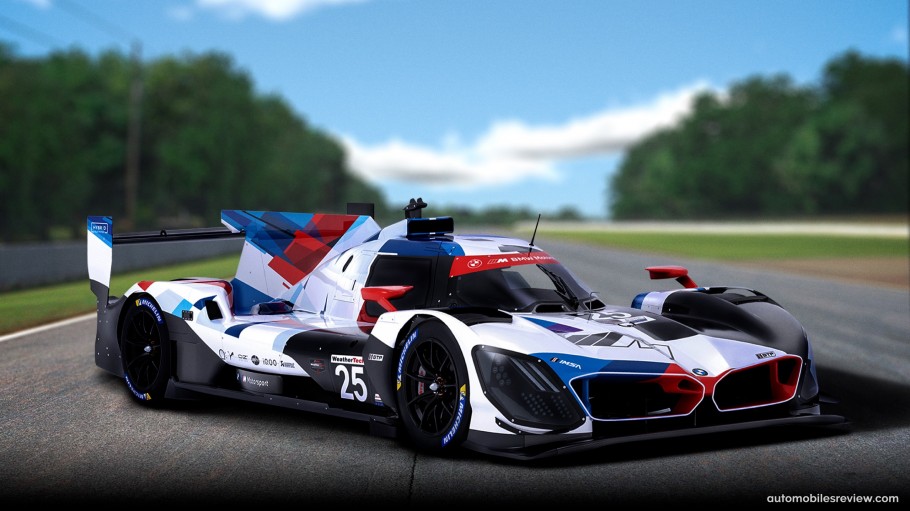BMW M Hybrid V8 Racecar (2023)
BMW M Hybrid V8 Racecar
The BMW M Hybrid V8 has arrived in North America and was presented to the public in its racing colours for the first time at a launch event at the Petersen Museum in Los Angeles (USA). The first prototype developed by BMW M Motorsport in 25 years will sport an avant-garde livery which leverages the iconic BMW M colours when it competes in the GTP class of the IMSA WeatherTech SportsCar Championship in 2023. The four core drivers who will take their place at the wheel of the two BMW M Team RLL cars were also announced at the Petersen Museum. They are BMW M works drivers Connor De Phillippi (USA), Philipp Eng (AUT), Augusto Farfus (BRA) and Nick Yelloly (GBR). When the car makes its race debut at Daytona (USA) in January 2023, they will receive big-name support from IndyCar series driver Colton Herta (USA).
Like the camouflage livery which the BMW M Hybrid V8 utilises while testing, the design for the racing season also comes from BMW Group Designworks under the programme leadership of Michael Scully. The works livery represents a significant departure from the heritage-based ‘Icons of IMSA’ camouflage with a future-facing coat of arms comprised of modern, bold, fractal blocks of the iconic M colours and the M logo. “These elements have been deconstructed to form what at first might appear to be an abstract triangular pattern across the BMW M Hybrid V8, but when viewed from the side, the M logo clicks right into place. – M reconstructed, if you will,” Scully explained.
The design also features ‘Mbedded’ references to the BMW logo, and utilises both blue and purple elements to pronounce the natural colours of electricity. Additionally the works livery carries BMW M Motorsport’s now-signature matte black extension ahead of the cockpit beneath the driver’s side of the windscreen, thereby extending BMW’s interior design hallmark of driver orientation to the exterior of the car for enhanced driver focus. In fact on the race-ready cars this non-reflective matt element will be the only black foil on the car, as all other black areas shown at the launch will remain in their native carbon fibre finish. “This measure allows us to reduce weight by 25 to 30 percent compared to a conventional livery for race cars. Less is more,” said Scully.

2023 BMW M Hybrid V8 Racecar
The debut of the BMW M Hybrid V8’s works livery also gives the first chance to see the car’s surfaces in non-camouflaged guise and to identify aspects of the design, which may have been previously obscured. The layout of the laser-lit kidneys coincides with the open, flow-through architecture of a modern prototype race car, and the air which passes beneath and through them is fundamental to the aerodynamic performance of the car; both in terms of cooling, but also for efficiency of downforce. The front of the car invokes the faceted hood, nested BMW logo, and inverted ‘Y’ configuration between the kidneys of the BMW M Vision Next, and is a great example of BMW’s showcars informing not only the production cars, but also the race cars. These elements, flanked by signature twin headlights on each side, make the front of the car unmistakably a BMW.
The kidneys’ lighting uses an exciting new technology. Innovative Swiss company L.E.S.S. SA has developed a new approach as an alternative to LED lighting where light is generated by a nano-active optical fibre trigged by a laser. This provides ultra-bright and ultra-uniform light within a very small form factor such that it considerably saves weight and energy when embedded onto a car. This technology was also presented as a future vision for the first time in the BMW M Vision Next in 2019. “
Transitioning around the side of the car, other BMW icons become apparent: the forward-leaning shark nose, the boomerang-shaped guide vane just behind the front wheel arch that summons the BMW M4’s air breather feature, the M mirrors and a modern interpretation of the Hofmeister kink. The sidepod carries a defined diagonal feature line which punctuates the radiused surface above it and at the same time also helps define the requisite front diffuser airflow exit. “A great example of the interdependence between BMW design DNA and dedicated efficiency which makes racing projects like this so engaging,” said Scully.
Chassis
| Length | 5,100 mm |
| Width | 2,000 mm |
| Wheelbase | 3,150 mm |
| Minimum weight | 1,030 kg |
Technical data - V8 P66/3 engine.
| Type | V-shaped Otto four-stroke twin-turbo engine |
| Capacity | 3,999 cc |
| Number of cylinders | 8 |
| Cylinder design | Cast aluminium cylinder block and cylinder head, cylinder lining as iron layer in LDS procedure |
| V angle | 90 ° |
| Bore | 93 mm |
| Stroke | 73.6 mm |
| Cylinder spacing | 102 mm |
| Valves per cylinder | 4 |
| Engine speed | max. 8,200 rpm |
| Output (regulated) | approx. 640 hp |
| Torque | approx. 650 Nm |
| Injection | High-pressure direct injection at 350 bar |
| Oil system | Dry sump system with six-cell oil drain pump and oil tank |

